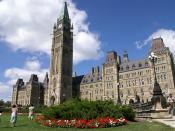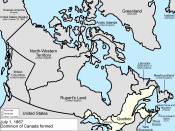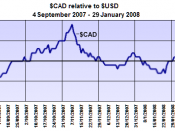To investigate the state of the Canadian economy, it is very useful to track
Canada's six major economic goals: economic growth, economic stability, economic
efficiency, economic equity, viable balance of payments, and low unemployment. At a
given time, Canada is achieving some of these goals while falling behind on some of the others.
When taken all into consideration, these goals give an indication of how well Canada has been doing
and the stage of the business cycle the Canadian economy is in. In 1996-1997, Canada is
in slight recession and is only meeting the goals of economic stability, and viable balance
of payments.
Canada can be said to be in a period of slight recession because there is a downswing
in economic activity. To confirm a true recovery, 'an economy must show no growth for
two consecutive quarters.' However, Canada is not in a true recession because there was a
3.0% growth in the third quarter, compared to 2.2% in the second quarter. Eventhough it is not
true recession, the slow growth is a sure sign of a slight one. Low inflation is also
is also prevalent and is symptomatic of a weak economy. A low inflation rate of 1.4% in November
1996 does not provide much of an indication for economic growth and expansion. A shrinking positive
balance of payments indicates these are tough economic times. A fourth indication of a slight
recession is the high unemployment rate. An unemployment rate of 10.0% in November 1996 is
definitely not a sign of strong economic recovery.
Canada is always trying to work towards the goal of economic growth. Economic growth
is the percentage change of GDP over a period of time and is also known as the growth rate.
In 1996, Canada's GDP has been increasing slowly since the...


